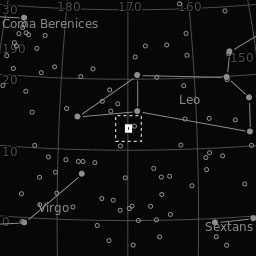
M 65 and M 66
Spiral galaxies in the constellation Leo.

Spiral galaxies in the constellation Leo.
Messier 65 (also called NGC 3623) is the disc-shaped galaxy in this image. It is a 9.2 mag bright spiral galaxy of the Hubble type Sb in the constellation Leo. Messier 66 (also called NGC 3627) is an 8.9 mag bright spiral galaxy also of the Hubble type Sb.
| Object: | M 65 and M 66 |
| Date of exposures: | 01.04.2019, 02.04.2019 |
| Distance: | 32 Mio. Lightyears |
| Exposures: | Luminance: 69 x 180", RGB: 72 x 180", sum: 7,1 hrs. |
| Telescope: | 10'', F4 Newton |
| Focal length: | 1000 mm |
| Filter: | Astrodon LRGB E-Series |
| Camera: | ASI 1600 MMC Pro |
| Guiding: | Off Axis Guider, Lodestar |
| Mount: | EQ8 |
Together with Messier 66 and NGC 3628 (not shown), the galaxy Messier 65 forms the Leo triplet, the nucleus of the M66 galaxy group, which is about 32 million light years away. Messier 65 was discovered on 1 March 1780 by the French astronomer Charles Messier. The galaxy is already visible in a powerful binocular.
The actual diameter of M 66 is about 100,000 light-years. In M 66, the supernova SN 1989B (type Ia) and the possible supernova SN 1997bs were observed, which could also have been an LBV eruption.
A study with the Hubble space telescope shows active regions in the H-alpha spectral line. A superposition of the visual spectrum with an infrared image of the Spitzer Space Telescope and an image of the gamma radiation by the Chandra Space Telescope reveals the distribution of black holes.
This galaxy belongs to the class of spiral galaxies with separated sections (Arp catalogue). Halton Arp divided his catalogue of unusual galaxies into groups according to purely morphological criteria.